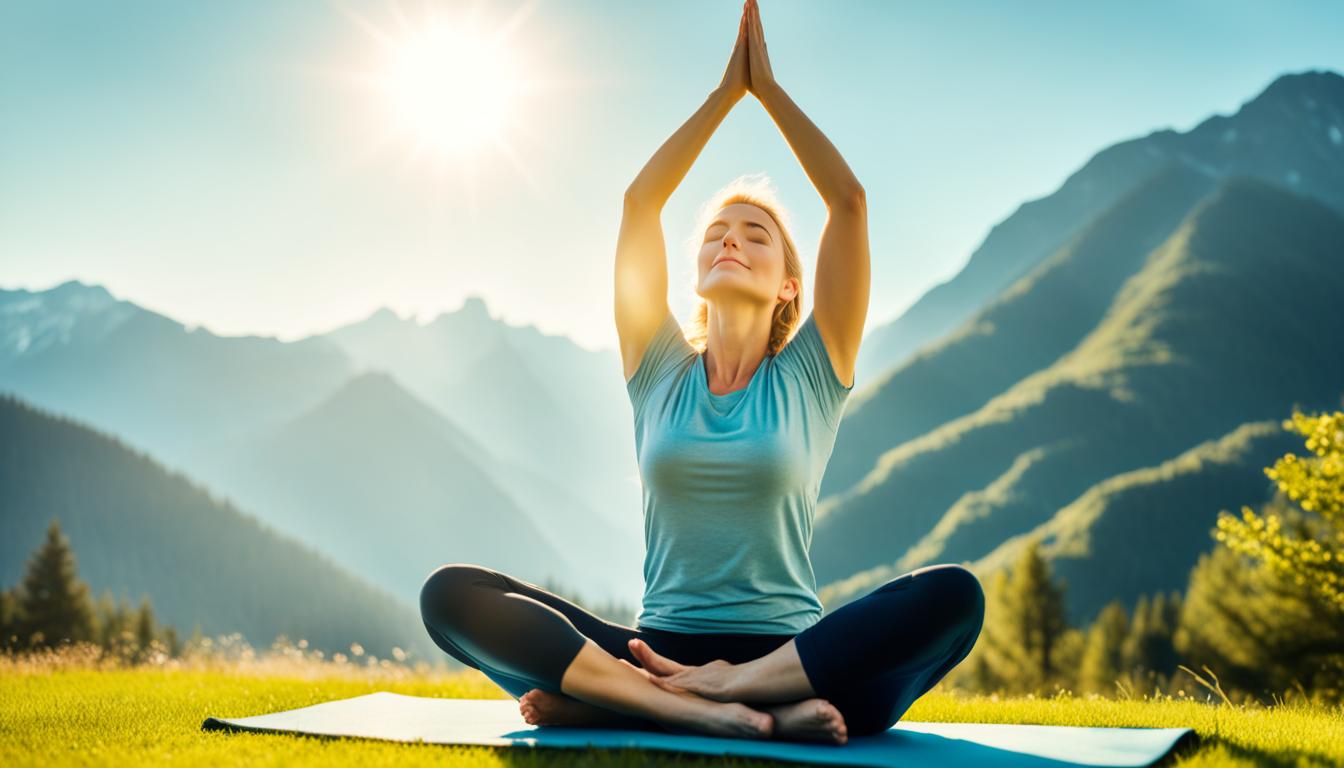Discover the power of meditative movement and how it can help you find inner peace and tranquility in your daily life. Meditative movement, also known as mindful exercise or movement meditation, combines physical movement with mindfulness to create an integrative body-mind practice that promotes overall well-being.
Whether you prefer contemplative movement practices like yoga, Tai Chi, or Qigong, or simply enjoy meditative walking or mind-body movement therapy, incorporating these practices into your routine can bring a sense of calm and balance to your mind and body.
By engaging in the gentle and flowing movements of meditative practices, you can cultivate a deeper connection with your body and tap into the present moment. The combination of physical movement and mindfulness allows you to release stress, improve focus, and enhance your overall well-being.
Key Takeaways:
- Meditative movement combines physical movement with mindfulness.
- It can help cultivate inner peace and tranquility.
- Practices like yoga, Tai Chi, and meditative walking are forms of meditative movement.
- Meditative movement promotes stress reduction and overall well-being.
- By incorporating meditative movement into your daily routine, you can experience the benefits in your mind and body.
Understanding Mindful Movement Meditation
Mindful Movement Meditation combines the principles of mindfulness and physical movement to cultivate a deep sense of presence and awareness. Mindfulness involves focusing on the present moment and accepting your thoughts, feelings, and bodily sensations without judgment. With Mindful Movement Meditation, you bring your attention to the sensations in your body as you move, cultivating a sense of presence and awareness.
This type of meditation can be practiced through various movement-based disciplines like yoga, Tai Chi, or Qigong. The coordinated movements and breathwork in Mindful Movement Meditation enhance the mind-body connection and promote a state of flow, where you become fully absorbed in the present moment. This practice also offers an opportunity for self-expression, self-discovery, and emotional healing.

By combining physical movement with mindfulness, Mindful Movement Meditation allows you to engage both your body and mind, fostering a deeper connection between the two. This integration of physical and mental aspects promotes overall well-being, balance, and inner harmony. Through mindful movement, you can experience a greater sense of embodiment, finding peace and tranquility within yourself.
The Benefits of Mindful Movement Meditation
Mindful Movement Meditation offers a wide range of physical and mental benefits. On a physical level, regular practice can improve flexibility, muscle strength, balance, and posture. It can also help release tension and increase body awareness. By engaging in intentional and controlled movements, you become more attuned to your body and can identify areas of tension or discomfort.
This practice fosters a deeper mind-body connection and promotes overall physical well-being. By focusing on your movements and the sensations they create in your body, you can develop a greater sense of body awareness and improve your physical performance. This heightened awareness allows you to make adjustments to your posture, alignment, and movement patterns, leading to better overall body mechanics and reduced risk of injury.
On a mental level, Mindful Movement Meditation enhances focus, relieves stress, and reduces symptoms of anxiety and depression. The combination of movement, focused attention, and deep breathing helps regulate your emotions and cultivates a sense of emotional stability. As you engage in the mindful movement practice, the rhythmic movements and coordinated breathwork create a calming effect, which can reduce stress and induce a state of relaxation.
The meditative aspect of Mindful Movement Meditation provides a space for self-reflection and introspection. During the practice, you may observe thoughts, feelings, and sensations arising in your mind and body. This self-awareness allows you to gain insights and perspectives, leading to a greater understanding of yourself and a deeper connection to your inner wisdom. It can also facilitate emotional healing and provide a sense of emotional well-being.

By incorporating Mindful Movement Meditation into your life, you can experience the numerous physical and mental benefits it offers. Regular practice can improve your flexibility, muscle strength, balance, and posture, while also enhancing your focus, relieving stress, and reducing symptoms of anxiety and depression. This practice provides a space for self-reflection and emotional healing, promoting a greater sense of self-awareness and overall well-being.
How to Practice Mindful Movement Meditation
Before embarking on a Mindful Movement Meditation practice, it is important to prepare yourself adequately. Choose a quiet and comfortable space where you won’t be disturbed, wear loose and breathable clothing that allows for unrestricted movement, and set your intention for the practice. Approach the practice with an open mind and be prepared for self-reflection and introspection.
Once you are ready, assume a standing or sitting position, depending on the movement you choose. Take slow, deep breaths to anchor your awareness in the present moment. Engage in mindful movements, bringing your attention to the physical sensations and coordinating your breath with your movements. Allow yourself to explore different movements and postures, and listen to your body intuitively.
Remember to maintain a state of mindfulness and non-judgment throughout the practice, accepting any thoughts or emotions that arise without getting caught up in them. Practice regularly to experience the full benefits of Mindful Movement Meditation.

“Choose a quiet and comfortable space where you won’t be disturbed, wear loose and breathable clothing that allows for unrestricted movement, and set your intention for the practice.” – Mindful Movement Meditator
Incorporating Meditative Movement in Daily Life
Meditative movement holds the key to promoting mindfulness and enhancing overall well-being in your daily life. By incorporating mindful practices into routine activities, you can cultivate a sense of presence, reduce stress, and foster a balanced and mindful living.
Mindful Walking
When you take a walk, bring your attention to each step you take. Feel the ground beneath your feet, notice the sensation of your muscles working, and embrace the rhythm of your breath. By being fully present in the act of walking, you can turn this mundane activity into a meditative experience.
Mindful Eating
Transform mealtime into a mindfulness practice by savoring each bite. Engage your senses as you observe the colors, textures, and aromas of your food. Take your time to chew slowly and notice the flavors unfolding in your mouth. By being fully aware of the tastes and sensations, you can cultivate a greater appreciation for nourishing your body.
Mindful Exercise
During your physical activity, whether it’s yoga, running, or dancing, bring your focus to the sensations in your body. Notice the movement of your muscles, the rhythm of your breath, and the energy flowing through you. By being fully engaged in the present moment, you can maximize the benefits of your exercise routine and develop a deeper mind-body connection.
Mindful Chores
Approach household tasks with mindfulness and presence. Instead of rushing through them or thinking about other things, focus on the process itself. Pay attention to the details, the movements involved, and the sense of accomplishment you feel along the way. By infusing mindfulness into your chores, you can turn them from mundane tasks into opportunities for self-reflection and tranquility.
Mindful Relationships
Cultivate mindfulness in your relationships by being fully present and attentive when interacting with others. Listen deeply, without judgment or distraction, and respond with intention and kindness. By fostering meaningful connections and prioritizing mindfulness in your relationships, you can create a harmonious and supportive environment for yourself and those around you.
Incorporating meditation and mindfulness into your daily life doesn’t have to be limited to dedicated practice sessions alone. By infusing meditative movement into your routines and activities, you can experience the transformative power of mindfulness and enjoy a more balanced and fulfilling life.

Conclusion
Meditative movement practices, such as Mindful Movement Meditation, provide a transformative journey towards inner peace, tranquility, and overall well-being. By combining mindfulness and physical movement, these practices allow you to experience a deep sense of presence and self-awareness.
Mindful Movement Meditation creates a nurturing space for self-reflection, relaxation, and emotional healing. This integrative practice not only enhances physical flexibility, strength, balance, and posture but also alleviates stress, anxiety, and depression.
By incorporating meditative movement into your daily life, you can seamlessly integrate mindfulness into your routines. Embrace the calm and serenity offered by these practices as you cultivate a mindful and balanced life. Remember, inner peace is a personal journey, so explore different meditative movement techniques and find what resonates with you. Let the power of Meditative Movement guide you towards a life filled with tranquility, mindfulness, self-awareness, and overall well-being.
FAQ
What is Meditative Movement?
Meditative Movement, also known as Mindful Exercise or Movement Meditation, is an integrative body-mind practice that combines mindfulness and physical movement to cultivate presence, awareness, and inner peace.
How does Mindful Movement Meditation work?
Mindful Movement Meditation involves focusing on the present moment and bringing attention to the physical sensations in the body as you move. This practice promotes a sense of presence, awareness, and emotional healing.
What are the benefits of Mindful Movement Meditation?
Mindful Movement Meditation offers physical benefits such as improved flexibility, strength, balance, and posture. It also provides mental benefits, including stress relief, reduced symptoms of anxiety and depression, and enhanced focus and emotional well-being.
How can I practice Mindful Movement Meditation?
To practice Mindful Movement Meditation, prepare a tranquil environment, wear comfortable clothing, and approach the practice with an open mind and intention. Engage in mindful movements, focusing on the physical sensations and coordinating them with your breath.
Can I incorporate Meditative Movement in my daily life?
Yes, you can incorporate Meditative Movement into your daily life. Mindful walking, mindful eating, mindful exercise, mindful chores, and mindful relationships are some ways to cultivate mindfulness, reduce stress, and enhance overall well-being.
How can Meditative Movement help me find inner peace?
Meditative Movement practices help cultivate inner peace by promoting mindfulness, self-awareness, and emotional balance. By embracing calm and serenity, these practices can guide you on your personal journey towards inner peace and tranquility.
Source Links
- https://www.mindful.org/a-gentle-movement-practice-to-connect-to-your-brave-heart/
- https://www.aurahealth.io/blog/experience-mindful-movement-meditation-for-a-calmer-mind-and-body
- https://www.calm.com/blog/inner-peace


